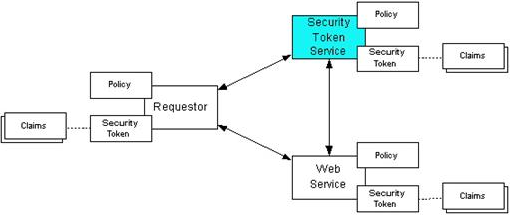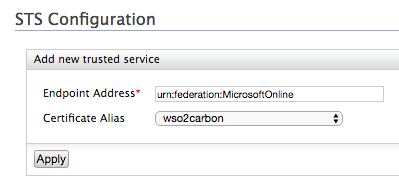Requesting and Renewing Received SAML2 Bearer Type Tokens¶
WSO2 Security Token Service is shipped as the resident identity provider of WSO2 Identity Server. The responsibility of a Security Token Service (STS) is to provide tokens that are trusted by a relying party to a requester or service consumer.
Terms and concepts¶
The following terminology is used extensively in this topic:
-
RST : Request for a Security Token. This is the initial request sent by a requester to a STS requesting for a security token. Basically this is a XML tag introduced in the WS-Trust specification.
<wst:RequestSecurityToken xmlns:wst="http://schemas.xmlsoap.org/ws/2005/02/trust"> -
RSTR : Response for a Security Token Request. This is the response issued by the STS along with a signed security token to the requested party.
<wst:RequestSecurityTokenResponse xmlns:wst="http://schemas.xmlsoap.org/ws/2005/02/trust"> -
Claim : A statement made about something. For example,
<email>[email protected]</email>is a claim about client’s email address. - Relying Party : The service provider who trusts the security token service. In the figure below, ‘Web Service’ is considered a relying party. (This is referred to as ‘Relying Party’ since STS is also a service provider as well as a Web service that can be described using WSDL).
How STS works¶

The following communication paths are illustrated in the above figure using arrows.
-
- The requester provides credentials to STS and grant a security token by sending a RST to the STS or from a third party application.
- STS validates the client credentials and reply with security token (SAML) to the requester.
- The token is then submitted to the relying party(web service) by the requester in order to access its services.
- The Web service either trusts the issuing security token service or may request a token service to validate the token (or the Web service may validate the token itself).
- Then STS send the decision to the web service.
- If the token is valid then web service allow accessing the protected resource(s).
Requesting tokens¶
Configuring the Identity Server to request tokens¶
You must do the configuration in this section to simulate the scenario with WSO2 identity Server. According to the specification, there are three parties communicating with each other and trusting each other. You can equate each party to the following in order to understand the simulation of the scenario.
- STS : WSO2 Identity Server’s resident identity provider (WSO2 STS)
- Relying Party : Echo Service of WSO2 ESB
- Requester : STS Sample Client
Do the following to configure this.
- Run WSO2 Identity Server on the default port (9443). See the Installation Guide guide for information on how to download and run the product.
- Navigate to the resident identity provider section from Main menu, by clicking Resident under Identity Providers.
- Expand the Security Token Service Configuration section under
Inbound Authentication Configuration.

- Set inbound authentication properties by providing the username token to authenticate requesters before issuing tokens. This is done to secure the STS from issuing tokens to every individual who sends a RSTs. To do this, click Apply Security Policy.
- Select UserNameToken (in this security scenario, the requester should submit a username and a password in order to get a security token, as described in WS-Security. By default, the username and password are similar to management console user name and password (“admin”,”admin”).
- Add all user groups from the next window and click Finish.
Running the requester¶
You can run the STS client without setting the relying party in IS in order to grant a security token. It is not necessary to have a relying party to grant the security token from the STS.
- Navigate to
<IS_SAMPLES>/modules/samples/sts/sts-clientdirectory.
The client code is written to send RSTs to a given endpoint defined in the<IS_SAMPLES>/modules/samples/sts/sts-client/src/main/resources/client.propertiesfile. - The following is the service URL of the STS if you have started the
IS on default port:
https://localhost:9443/services/wso2carbon-sts -
Without changing any of the properties you can safely run the client via the shell script that is inside the
<IS_SAMPLES>/modules/samples/sts/sts-clientdirectory.sh sts-client.shIt prints the received SAML assertion on the terminal. You can also view the RST and RSTR on the SOAP tracer of the Management Console in the Identity Server.
Changing the client properties¶
Client configurations can be modified using the client.properties file, which is located in the src/main/resources directory.
-
You can change the relying party address in this file. In this instance, the endpoint URL of the WSO2 ESB echo service is provided.
address.relyingParty=http://localhost:8281/services/echo -
The SAML version of the RST can be changed in this file (depending on the version, the SAML assertion issued from the STS can be modified).
saml.token.type=2.0 -
You can also specify the username and password for the UsernameToken security policy.
ut.username=admin ut.password=admin
Renewing received tokens¶
The SAML 2.0 tokens that are received by the Identity Server can eventually expire according to the following attribute specification. This section defines how to renew the received bearer type SAML 2.0 token using the WSO2 Identity Server’s resident token service.
<wsu:Created>2014-08-19T09:41:55.832Z</wsu:Created>
<wsu:Expires>2014-08-19T09:46:55.832Z</wsu:ExpiresAfter the security token service is configured(refer Configuring the Identity Server to request tokens ) you can follow the below steps to run the STS client as the token renewer.
Running the client¶
The client supports command line arguments to select the SAML Version and send token renew requests.
-
Using the configuration file in src/main/resources/ you can enable the renew property to send renew requests to the server.
enable.renew=true -
You can specify SAML version on the command line. For SAML version 2.0, the following is the command.
sh sts-client.sh samlVersion 2.0For SAML 1.1, the following can be used.
sh sts-client.sh samlVersion 1.1
Testing out the scenario¶
-
If you want to send a request for a SAML 2.0 security token, then to renew it and validate the renewed token you can do following configurations.
enable.binding.validate=true enable.renew=true -
Then run the following for the version of SAML you are using.
sh sts-client.sh samlVersion 2.0You can see the original SAML assertion and the renewed assertion printed on the console.
Here is the response for SAML 2.0 security token request and a renewal response.
Initial SAML Assertion
<saml2:Assertion xmlns:saml2="urn:oasis:names:tc:SAML:2.0:assertion" xmlns:xs="http://www.w3.org/2001/XMLSchema" ID="urn:uuid:6E835985EF7F8C729E1412054251018" IssueInstant="2014-09-30T05:17:31.016Z" Version="2.0"><saml2:Issuer>localhost</saml2:Issuer><ds:Signature xmlns:ds="http://www.w3.org/2000/09/xmldsig#">
<ds:SignedInfo>
<ds:CanonicalizationMethod Algorithm="http://www.w3.org/2001/10/xml-exc-c14n#" />
<ds:SignatureMethod Algorithm="http://www.w3.org/2000/09/xmldsig#rsa-sha1" />
<ds:Reference URI="#urn:uuid:6E835985EF7F8C729E1412054251018">
<ds:Transforms>
<ds:Transform Algorithm="http://www.w3.org/2000/09/xmldsig#enveloped-signature" />
<ds:Transform Algorithm="http://www.w3.org/2001/10/xml-exc-c14n#"><ec:InclusiveNamespaces xmlns:ec="http://www.w3.org/2001/10/xml-exc-c14n#" PrefixList="xs" /></ds:Transform>
</ds:Transforms>
<ds:DigestMethod Algorithm="http://www.w3.org/2000/09/xmldsig#sha1" />
<ds:DigestValue>15wzu6K5Mk1Ffwvxx67MP0k2sDU=</ds:DigestValue>
</ds:Reference>
</ds:SignedInfo>
<ds:SignatureValue>
LaXHKhd8SFGGvBnNoICaSAlwRxxzZMQD5zjqtQ3quAY7fogVJo5QHBJwDLI8k2zl6X0s6z/PWcJx
20CZ+UrJZjnbp0mslVl3iM7U7SWD5bSPkrlPwFgiXh6CO/qmdfCPnBNdNGqgZPCQX4o6AR4+ohox
zxp7hJm+RhpMZhHj8Tk=
</ds:SignatureValue>
<ds:KeyInfo><ds:X509Data><ds:X509Certificate>MIICNTCCAZ6gAwIBAgIES343gjANBgkqhkiG9w0BAQUFADBVMQswCQYDVQQGEwJVUzELMAkGA1UE
CAwCQ0ExFjAUBgNVBAcMDU1vdW50YWluIFZpZXcxDTALBgNVBAoMBFdTTzIxEjAQBgNVBAMMCWxv
Y2FsaG9zdDAeFw0xMDAyMTkwNzAyMjZaFw0zNTAyMTMwNzAyMjZaMFUxCzAJBgNVBAYTAlVTMQsw
CQYDVQQIDAJDQTEWMBQGA1UEBwwNTW91bnRhaW4gVmlldzENMAsGA1UECgwEV1NPMjESMBAGA1UE
AwwJbG9jYWxob3N0MIGfMA0GCSqGSIb3DQEBAQUAA4GNADCBiQKBgQCUp/oV1vWc8/TkQSiAvTou
sMzOM4asB2iltr2QKozni5aVFu818MpOLZIr8LMnTzWllJvvaA5RAAdpbECb+48FjbBe0hseUdN5
HpwvnH/DW8ZccGvk53I6Orq7hLCv1ZHtuOCokghz/ATrhyPq+QktMfXnRS4HrKGJTzxaCcU7OQID
AQABoxIwEDAOBgNVHQ8BAf8EBAMCBPAwDQYJKoZIhvcNAQEFBQADgYEAW5wPR7cr1LAdq+IrR44i
QlRG5ITCZXY9hI0PygLP2rHANh+PYfTmxbuOnykNGyhM6FjFLbW2uZHQTY1jMrPprjOrmyK5sjJR
O4d1DeGHT/YnIjs9JogRKv4XHECwLtIVdAbIdWHEtVZJyMSktcyysFcvuhPQK8Qc/E/Wq8uHSCo=</ds:X509Certificate></ds:X509Data></ds:KeyInfo></ds:Signature><saml2:Subject><saml2:NameID Format="urn:oasis:names:tc:SAML:1.1:nameid-format:emailAddress">admin</saml2:NameID><saml2:SubjectConfirmation Method="urn:oasis:names:tc:SAML:2.0:cm:bearer" /></saml2:Subject><saml2:Conditions NotBefore="2014-09-30T05:17:31.016Z" NotOnOrAfter="2014-09-30T05:22:31.016Z"><saml2:AudienceRestriction><saml2:Audience>https://localhost:10443/services/echo</saml2:Audience></saml2:AudienceRestriction></saml2:Conditions><saml2:AuthnStatement AuthnInstant="2014-09-30T05:17:31.016Z"><saml2:AuthnContext><saml2:AuthnContextClassRef>urn:oasis:names:tc:SAML:2.0:ac:classes:Password</saml2:AuthnContextClassRef></saml2:AuthnContext></saml2:AuthnStatement><saml2:AttributeStatement><saml2:Attribute Name="http://wso2.org/claims/emailaddress" NameFormat="http://wso2.org/claims/emailaddress"><saml2:AttributeValue xmlns:xsi="http://www.w3.org/2001/XMLSchema-instance" xsi:type="xs:string">[email protected]</saml2:AttributeValue></saml2:Attribute><saml2:Attribute Name="http://wso2.org/claims/givenname" NameFormat="http://wso2.org/claims/givenname"><saml2:AttributeValue xmlns:xsRenewed Assertion
<saml2:Assertion xmlns:saml2="urn:oasis:names:tc:SAML:2.0:assertion" xmlns:xs="http://www.w3.org/2001/XMLSchema" ID="urn:uuid:6E835985EF7F8C729E1412054251018" IssueInstant="2014-09-30T05:17:31.016Z" Version="2.0"><saml2:Issuer>localhost</saml2:Issuer><ds:Signature xmlns:ds="http://www.w3.org/2000/09/xmldsig#">
<ds:SignedInfo>
<ds:CanonicalizationMethod Algorithm="http://www.w3.org/2001/10/xml-exc-c14n#" />
<ds:SignatureMethod Algorithm="http://www.w3.org/2000/09/xmldsig#rsa-sha1" />
<ds:Reference URI="#urn:uuid:6E835985EF7F8C729E1412054251018">
<ds:Transforms>
<ds:Transform Algorithm="http://www.w3.org/2000/09/xmldsig#enveloped-signature" />
<ds:Transform Algorithm="http://www.w3.org/2001/10/xml-exc-c14n#"><ec:InclusiveNamespaces xmlns:ec="http://www.w3.org/2001/10/xml-exc-c14n#" PrefixList="xs" /></ds:Transform>
</ds:Transforms>
<ds:DigestMethod Algorithm="http://www.w3.org/2000/09/xmldsig#sha1" />
<ds:DigestValue>S2GS5Q2WFl4i2FupmZr+F8g8tfo=</ds:DigestValue>
</ds:Reference>
</ds:SignedInfo>
<ds:SignatureValue>
CUwxOhZDFQ0NdQiHz0gMBl0hsLn6eYegxSdQ+TjrsvMwrlacnSnRRT+1uMX5vCStgtm9bkI5dweS
Z1fZX3WGka0N7MHbly98H4a/2fpZIJari++/RVa68or3O80SwoJqIdnKwt1q5xPBhndpzgXEp3J7
hBPYVH4IsZYnaPpdfNk=
</ds:SignatureValue>
<ds:KeyInfo><ds:X509Data><ds:X509Certificate>MIICNTCCAZ6gAwIBAgIES343gjANBgkqhkiG9w0BAQUFADBVMQswCQYDVQQGEwJVUzELMAkGA1UE
CAwCQ0ExFjAUBgNVBAcMDU1vdW50YWluIFZpZXcxDTALBgNVBAoMBFdTTzIxEjAQBgNVBAMMCWxv
Y2FsaG9zdDAeFw0xMDAyMTkwNzAyMjZaFw0zNTAyMTMwNzAyMjZaMFUxCzAJBgNVBAYTAlVTMQsw
CQYDVQQIDAJDQTEWMBQGA1UEBwwNTW91bnRhaW4gVmlldzENMAsGA1UECgwEV1NPMjESMBAGA1UE
AwwJbG9jYWxob3N0MIGfMA0GCSqGSIb3DQEBAQUAA4GNADCBiQKBgQCUp/oV1vWc8/TkQSiAvTou
sMzOM4asB2iltr2QKozni5aVFu818MpOLZIr8LMnTzWllJvvaA5RAAdpbECb+48FjbBe0hseUdN5
HpwvnH/DW8ZccGvk53I6Orq7hLCv1ZHtuOCokghz/ATrhyPq+QktMfXnRS4HrKGJTzxaCcU7OQID
AQABoxIwEDAOBgNVHQ8BAf8EBAMCBPAwDQYJKoZIhvcNAQEFBQADgYEAW5wPR7cr1LAdq+IrR44i
QlRG5ITCZXY9hI0PygLP2rHANh+PYfTmxbuOnykNGyhM6FjFLbW2uZHQTY1jMrPprjOrmyK5sjJR
O4d1DeGHT/YnIjs9JogRKv4XHECwLtIVdAbIdWHEtVZJyMSktcyysFcvuhPQK8Qc/E/Wq8uHSCo=</ds:X509Certificate></ds:X509Data></ds:KeyInfo></ds:Signature><saml2:Subject><saml2:NameID Format="urn:oasis:names:tc:SAML:1.1:nameid-format:emailAddress">admin</saml2:NameID><saml2:SubjectConfirmation Method="urn:oasis:names:tc:SAML:2.0:cm:bearer" /></saml2:Subject><saml2:Conditions NotBefore="2014-09-30T05:17:31.439Z" NotOnOrAfter="2014-09-30T05:22:31.439Z" /><saml2:AuthnStatement AuthnInstant="2014-09-30T05:17:31.016Z"><saml2:AuthnContext><saml2:AuthnContextClassRef>urn:oasis:names:tc:SAML:2.0:ac:classes:Password</saml2:AuthnContextClassRef></saml2:AuthnContext></saml2:AuthnStatement><saml2:AttributeStatement><saml2:Attribute Name="http://wso2.org/claims/emailaddress" NameFormat="http://wso2.org/claims/emailaddress"><saml2:AttributeValue xmlns:xsi="http://www.w3.org/2001/XMLSchema-instance" xsi:type="xs:string">[email protected]</saml2:AttributeValue></saml2:Attribute><saml2:Attribute Name="http://wso2.org/claims/givenname" NameFormat="http://wso2.org/claims/givenname"><saml2:AttributeValue xmlns:xsAdditionally, if the renewed token is validated, you can see the following.
Renewed SAML 2.0 Token is valid